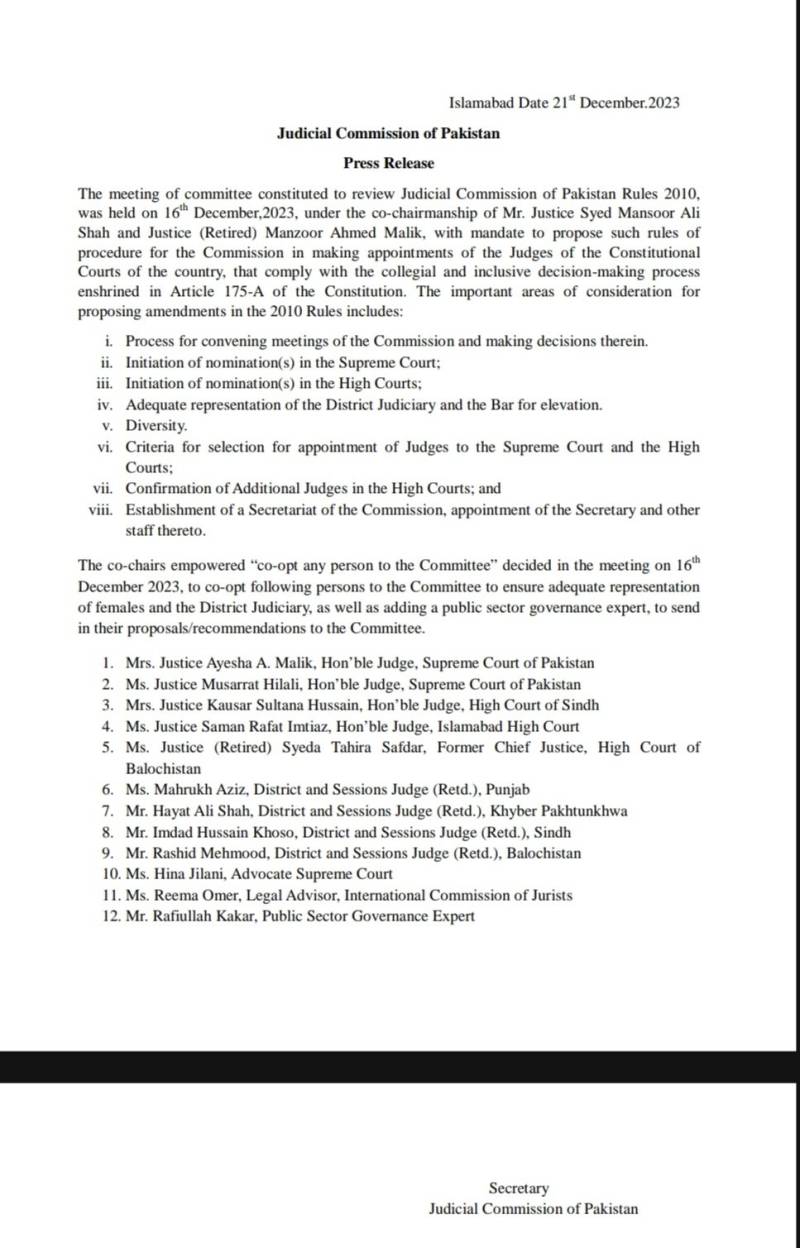
On December 21, 2023, the press release of Judicial Commission of Pakistan (JCP) revealed that the Committee set up by the Chairman of the Commission to review the JCP Rules 2010 was empowered to ‘co-opt any person to the Committee’.
The press release also highlighted that on a prior meeting dated December 16, 2023, the co-chairs of the said Committee had decided to co-opt twelve persons including notable female lawyers, members from district judiciary, public sector and hon’ble judges of the Supreme Court, requesting them to send in their proposals and recommendations for reform of the JCP Rules 2010, for consideration by the Committee that has been tasked to finalize the same by December 29, 2023. This leaves a rather short time for the co-opted persons to send in their recommendations on a rather grand subject that requires in-depth consideration. Perhaps a revised timeline would have been useful considering this development.
The Committee has sought written proposals from the additional persons without there being any clarity on whether the persons would be able to engage in any other way with the members of the Committee or not, to present their views. Further, to what extent will the proposals be considered and given due weight is also difficult to say at this point as that remains a discretion of the Committee.
I am not sure if submission of proposals alone, without there being an opportunity for the stakeholders to engage further in a more meaningful and participatory manner, would be able to do justice to this much needed opportunity that has been attempted by the Committee. The opportunity is novel, very welcome, and extremely important as reforms are rare and may take decades before another is attempted so it is even more vital to ensure that such an opportunity is not lost in any way.
As stated in UN General Comment No 12 (2009), on right to be heard, “if participation is to be effective and meaningful, it needs to be understood as a process, not as an individual one-off event”.
Eight important areas have been identified on which the recommendations have been sought, namely on:
1. Process for convening meetings of the Commission and making decisions therein;
2. Initiation of nomination(s) in the Supreme Court;
3. Initiation of nomination(s) in the High Courts;
4. Adequate representation of the District Judiciary and the Bar for elevation;
5. Diversity;
6. Criteria for selection for appointment of Judges of the Supreme Court and the High Courts;
7. Confirmation of Additional Judges in the High Courts;
8. Establishment of the Secretariat of the Commission, appointment of the Secretary and other staff thereto.
Amongst these eight areas, women’s fair representation in justice sector does not feature as a stand-alone consideration, rather it appears that ‘diversity’ is the head under which it is expected to be considered. While that is a step forward from the point when none of these factors were even put on the table for discussion, it has to be said that the question of women’s fair representation is essentially about factors and conditions that can enable equal participation of women taking into consideration the structural, invisible and other barriers that hold women back from advancement in the justice sector. It is a much larger debate than simply checking ‘diversity’ as a metric.
It is about understanding that there are greater and wider underlying inequities in the system that hold women back from equal participation such as for instance discouragement from active legal practice, unequal allocation of work, lack of enabling infrastructure, child-care responsibilities etc, therefore, for instance, simply inserting quota or reserved seats would not be sufficient unless there is an appreciation of the challenges that impact pipeline of eligible female candidates.
What is required is a system, structures and policies that enable women’s equal participation in decision-making roles and bodies taking into account of all of these factors.
At the very least, it requires an understanding and appreciation that factors like ‘seniority’, ‘number of judgements’ etc. are some of those technical barriers that result in gatekeeping women’s access and advancement in the profession and consequently will impact their eligibility for judicial appointments if they are in any way entrenched.
The Committee having the opportunity to revise the Rules must keep these barriers in mind when deliberating on women’s inclusion which is not just a matter of ensuring diversity but more importantly a matter of equal opportunity and participation as well. It should ideally be a stand-alone point of its own so that it can be addressed fully.
Further, in interest of transparency and for greater public confidence in the process leading up to the finalization of the revision of the 2010 Rules, it would be helpful if all the proposals and recommendations so received are made public along with the revised Rules so that there is an opportunity to reflect on the entire process and outcome document in a meaningful way given how important a subject this is for fair representation of women in justice sector.
Ultimately, the revised Rules must take into consideration these factors and should focus on not just ensuring diversity in judicial appointments but also on transparency and on a process that enables equal participation and equal opportunities for women to be considered for judicial appointments. I am hopeful that that would be how it is.

